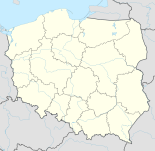Błażejów
| Błażejów | ||
|---|---|---|
 Help on coat of arms |
|
|
| Basic data | ||
| State : | Poland | |
| Voivodeship : | Lower Silesia | |
| Powiat : | Kamienna Góra | |
| Geographic location : | 50 ° 40 ′ N , 16 ° 3 ′ E | |
| Height : | 500-800 m npm | |
| Residents : | ||
| Telephone code : | (+48) 75 | |
| License plate : | DKA | |
| Economy and Transport | ||
| Street : | Kamienna Góra - Okrzeszyn | |
| Next international airport : | Wroclaw | |
Błażejów (German Blasdorf b. Schömberg ; 1935-1945 Tannengrund ) is a district of the rural community Lubawka ( Liebau ) in the Powiat Kamiennogórski ( Landeshuter District ) of the Polish Voivodeship of Lower Silesia . The border with the Czech Republic, which can be reached via the Lubawka – Královec border crossing, runs in the immediate vicinity.
Geographical location
Błażejów is located in the Raven Mountains in Lower Silesia , west of Chełmsko Śląskie ( Schömberg ), from where it is reached via a side street. Neighboring towns are Jawiszów ( Kleinhennersdorf ) and Krzeszów ( Grüssau ) in the north, Krzeszówek ( new ) Gorzeszów ( Görtelsdorf ) and Kokhanov ( Traut Dear village ) in the northeast, Różana ( Rosenau ) and Mieroszów ( Friedland ) to the east, Uniemyśl ( Berthelsdorf ) and Okrzeszyn ( Altendorf ) in the south and Ulanowice-Podlesie ( Ullersdorf ) in the northwest. Bečkov ( Potschendorf ) and Bernartice ( Berndorf ) in the southwest and Královec ( Königshan ) in the west lie across the border with the Czech Republic .
history
Blasdorf initially belonged to the Trautenau area in Bohemia . The first documentary mention comes from the year 1288, when the knight Witiko von Aupa / Alt Trautenau sold the places "Blaseysdorff", " Merkelinsdorff " and "Caczbach" ( Katzbach; Kratzbach ) to Duke Bolko I , who sold them in 1289 to the Benedictine Provosty Grüssau, which belonged to the Bohemian Opatowitz monastery . After the Opatowitz abbot Tschaska gave up the Grüssau provost in 1289 and sold the territory belonging to it to Duke Bolko in the same year, Blasdorf came to the Duchy of Schweidnitz . With the deed of foundation of 1292, Bolko transferred the villages "Blaseysdorff" and "Caczbach" to the newly founded Cistercian monastery Grüssau , with which Blasdorf remained connected until the monastery property was secularized in 1810. After the death of Duke Bolko II , Blasdorf and the Duchy of Schweidnitz came under inheritance law to the Crown of Bohemia , with Bolko's widow Agnes von Habsburg having a usufruct until her death in 1392 .
After the First Silesian War , Blasdorf fell to Prussia together with Silesia in 1742 . In 1747 there were 33 farmers and 79 cottagers in Blasdorf , including 14 craftsmen. After the secularization of the monastery property, Blasdorf became royal property in 1810. After the reorganization of Prussia in 1815, Blasdorf belonged to the province of Silesia and from 1816 was incorporated into the Landeshut district, with which it remained connected until 1945. It formed its own rural community and had belonged to the Voigsdorf district since 1874 , which was renamed the Erlendorf district in 1931 . In 1840 Blasdorf consisted of 104 buildings, including a school, as well as a starch and fulling mill. In addition to agriculture and forestry, house weaving was of economic importance until the middle of the 19th century. Later people found work in the mechanical weaving mills in Schömberg. In 1896 Blasdorf was connected to the Ziedertal Railway , which was extended to Albendorf ( Okrzeszyn ) in 1899 . In 1935, Blasdorf was renamed Tannengrund . In 1939 there were 410 inhabitants in Blasdorf / Tannengrund.
After the Second World War , Blasdorf / Tannendorf was placed under Polish administration by the Soviet occupying forces, like almost all of Silesia . The village was given the Polish name Błażejów . The German population was expelled. Some of the new residents were resettlers from areas east of the Curzon Line and had belonged to Polish minorities there. Due to the closure of the border to what was then Czechoslovakia and the suspension of passenger traffic on the railway line in 1954, Błażejów got into a remote location, so that many of the newly settled people left the place again. As a result, several houses were left to decay. Until 1959, goods were still transported on the railway line to Okrzeszyn. In 1973 the railway tracks were dismantled. 1975–1998 Błażejów belonged to the Jelenia Góra Voivodeship .
Population development
| year | Residents | Remarks |
|---|---|---|
| 1933 | 379 | |
| 1939 | 401 |
Web links
Individual evidence
- ↑ Sale by Witiko von Aupa to Bolko I. (PDF; 90 kB)
- ↑ P. Ambrosius Rose: Grüssau Monastery. Stuttgart 1974, ISBN 3-8062-0126-9 , pp. 17, 22-23
- ↑ District Voigsdorf / alder village
- ^ A b Michael Rademacher: German administrative history from the unification of the empire in 1871 to the reunification in 1990. landeshut.html. (Online material for the dissertation, Osnabrück 2006).
